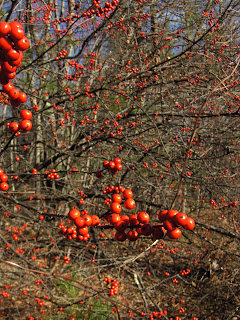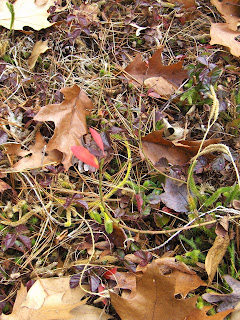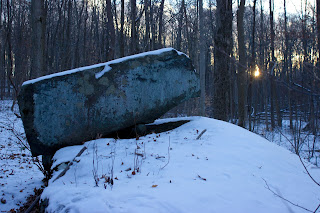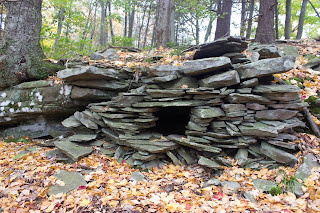From Groton. The usual treat is coming up on a big split rock from the back, wondering if there is a wedge. You peek around into the crack and....there it is!
I thought this was a good example because the wedge is too big a rock for me to lift.
Not at all a casual structure. Plus you wonder how the rock got split?
Monday, November 30, 2015
North slope of Horse Hill, Groton
Just a brief mention, two piles:
About the only level spot heading up the norther side. Closer:
One notes the outline. One notes the propper vertial of the first.
About the only level spot heading up the norther side. Closer:
One notes the outline. One notes the propper vertial of the first.
Sunday, November 29, 2015
Saturday, November 28, 2015
HI ALERT
Stow Grid, end of Gates Lane in Stow MA: the most accessible and largest and best preserved grid site around. Surveying for a 21 housing unit development is encroaching on the site. Please get involved, I am calling people I know in Stow.
Could that be a burial?
Better go have a look before it is too late.
You can park and see these structures. Just step into the woods and look uphill.
Could that be a burial?
Better go have a look before it is too late.
You can park and see these structures. Just step into the woods and look uphill.
Thursday, November 26, 2015
Ulster County NY Cairns
Reader Dwight B writes:
I found these rock cairns in the woods on top of a ridge in Ulster County, NY. Do you have any idea what type of structure they are and/or who built them and when?
[This last is called a "turtle" - PWAX]
I found these rock cairns in the woods on top of a ridge in Ulster County, NY. Do you have any idea what type of structure they are and/or who built them and when?
[This last is called a "turtle" - PWAX]
Monday, November 23, 2015
The pathway up from the water to the hill
I was exploring the northwestern part of Horse Hill in Groton, and ended up finding things in the 'saddle' between the hills, adjacent to places I already knew from previous visits. This led me up to a knoll with rock piles that seemed a bit familiar. But as I explored outward, back towards the northwest and downhill from the knoll, I kept finding more piles, each one visible from the previous, and leading back down hill.
See the blue outline on the map? Note the gully/ravine/small valley that starts at the saddle and goes along the (north) side of the knoll and leads down into the valley to the west. That is the valley of Unkety Brook, which I judge to have been a bit of a thoroughfare, not too distant from the Nashua River. What became obvious was that someone in the past, followed the path of least resistance up from the water to the west, leading to this knoll.
I have seen that before. At the North Andover Country Club [click here] at College Rock [click here] and maybe a couple other places. The idea is that people of the past traveled by water and, had a number of ceremonials on land that -naturally- used a defined pathway from the water up to the higher ground. Although I did not see a single well defined pathway, the same idea might apply to the piles from Mason NH "rail trail' I reported recently [click here]. When looking at the topo map fragment there, note how both spots 'A' and 'B' are accessible at the head of a valley. I usually interpret this as a tendency towards finding the source of the water. A slightly different interpretation is that getting to these spots follows a valley up from the water to the hill. It may be as much the "source of water" as it is a "path of least resistance". Perhaps these are the same thing. I thought I should name the phenomenon, per the title.
I expect to see grids or burials at the upper end of such a pathway. At Horse Hill there were rock piles with hollows built against boulders on the knoll.
I have written about piles with hollows on boulders being common at Horse Hill and places north of there. Here is a particularly nice one:
Another view:
Do you get the feeling we should pay attention to little niches built into the sides of piles? I see one on the right. On the left the little indentation is so typical, but I do not know what it is for. This is much like one from Mason [see here] where the piles were more decrepit than here.
There were other piles in there that were not built against boulders with hollows. For example:
The sense of "hollow" persists:
Then we start falling off the edge of the knoll to the northwest but the piles continue:
You can see back down to the water:
Lovely vertical-sided piles seem to guide me along as I go downhill:
Was that a niche? Was that a bent tree?
Maybe. I did not see other possible signs of more recent activity, so it could easily be natural. Here's another something against a boulder:
and here is one of the piles along the way:
(I am guessing Jim P. will like this one). As we get down off the steeper slope...there is stone wall following the contour of the hill. With a couple of piles along it.
This last one, at least, is a familiar "rectangle with hollow" in the form of a 'U' with the opening on the uphill side. These are quite common further to the south. I do not know if I can draw a conclusion from the apparent ages and apparent styles of the different piles shown here.
Update: As I look at those links above and follow other links they lead to, I see a great deal of similarity in the types of piles present at these places: Horse Hill (and north), College Rock, Mason NH, Gates Pond. We can list features to expect: a path up from the water, vertical sided piles along the way, topping out with mounds with hollows. An occasional short stretch of low wall, an occasional curve of separate rocks (not really 'wall') forming part of an outline or just a curve.
See the blue outline on the map? Note the gully/ravine/small valley that starts at the saddle and goes along the (north) side of the knoll and leads down into the valley to the west. That is the valley of Unkety Brook, which I judge to have been a bit of a thoroughfare, not too distant from the Nashua River. What became obvious was that someone in the past, followed the path of least resistance up from the water to the west, leading to this knoll.
I have seen that before. At the North Andover Country Club [click here] at College Rock [click here] and maybe a couple other places. The idea is that people of the past traveled by water and, had a number of ceremonials on land that -naturally- used a defined pathway from the water up to the higher ground. Although I did not see a single well defined pathway, the same idea might apply to the piles from Mason NH "rail trail' I reported recently [click here]. When looking at the topo map fragment there, note how both spots 'A' and 'B' are accessible at the head of a valley. I usually interpret this as a tendency towards finding the source of the water. A slightly different interpretation is that getting to these spots follows a valley up from the water to the hill. It may be as much the "source of water" as it is a "path of least resistance". Perhaps these are the same thing. I thought I should name the phenomenon, per the title.
I expect to see grids or burials at the upper end of such a pathway. At Horse Hill there were rock piles with hollows built against boulders on the knoll.
I have written about piles with hollows on boulders being common at Horse Hill and places north of there. Here is a particularly nice one:
Another view:
Do you get the feeling we should pay attention to little niches built into the sides of piles? I see one on the right. On the left the little indentation is so typical, but I do not know what it is for. This is much like one from Mason [see here] where the piles were more decrepit than here.
There were other piles in there that were not built against boulders with hollows. For example:
The sense of "hollow" persists:
Then we start falling off the edge of the knoll to the northwest but the piles continue:
You can see back down to the water:
Lovely vertical-sided piles seem to guide me along as I go downhill:
Was that a niche? Was that a bent tree?
Maybe. I did not see other possible signs of more recent activity, so it could easily be natural. Here's another something against a boulder:
and here is one of the piles along the way:
(I am guessing Jim P. will like this one). As we get down off the steeper slope...there is stone wall following the contour of the hill. With a couple of piles along it.
This last one, at least, is a familiar "rectangle with hollow" in the form of a 'U' with the opening on the uphill side. These are quite common further to the south. I do not know if I can draw a conclusion from the apparent ages and apparent styles of the different piles shown here.
Update: As I look at those links above and follow other links they lead to, I see a great deal of similarity in the types of piles present at these places: Horse Hill (and north), College Rock, Mason NH, Gates Pond. We can list features to expect: a path up from the water, vertical sided piles along the way, topping out with mounds with hollows. An occasional short stretch of low wall, an occasional curve of separate rocks (not really 'wall') forming part of an outline or just a curve.
Some colors from Groton and Dunstable
And just to give a bit of depth to my reasons for being here, this is a beaver swamp with fingers of land making peninsulas.
And some interesting features on the peninsulas.
Friday, November 20, 2015
Stow Grid - Threatened
Spindle Hill, at the end of Gates Lane, Stow is the best example of a grid that I know. As a refresher, the site looks something like this (numbers are in 'paces'):
Now I hear the town has marked the edge of this area with tape. Why would they do that? The land on the other side of the tape is private.
Please contact someone you know in Stow and ask them to help get this site better protected.
Now I hear the town has marked the edge of this area with tape. Why would they do that? The land on the other side of the tape is private.
Please contact someone you know in Stow and ask them to help get this site better protected.
Rock piles with holes
From Norman Muller:
I remembered seeing engravings of such a feature, and I am attaching them. These two images come from a Smithsonian publication from the late 1800s
I remembered seeing engravings of such a feature, and I am attaching them. These two images come from a Smithsonian publication from the late 1800s
Native American Sites on the Penobscott River and Maine Coast
From reader Teig Tyrson:
Hi Mr. Waksman, my 3 year research into the stone sites found in Bucksport, Maine is finally done and compiled into a research book with 3 other lost French and Native American sites on the Penobscot River and Maine Coast. I believe I have successfully tied in Rhode Island to the lost city of Arembec,(Norumbega) and the Great Chief Basheba assassination, as Chief Nanepashemet sent a large war party up to aid the Penobscots being overrun by the Tarratines after their chief was killed. This allows for a connection between the stone walls of Queen's Fort to my claimed stonewalls of Norumbega, dismissed as sheep walls by the preservation. The book and bio can be viewed here:http://www.amazon.com/Search-
Hi Mr. Waksman, my 3 year research into the stone sites found in Bucksport, Maine is finally done and compiled into a research book with 3 other lost French and Native American sites on the Penobscot River and Maine Coast. I believe I have successfully tied in Rhode Island to the lost city of Arembec,(Norumbega) and the Great Chief Basheba assassination, as Chief Nanepashemet sent a large war party up to aid the Penobscots being overrun by the Tarratines after their chief was killed. This allows for a connection between the stone walls of Queen's Fort to my claimed stonewalls of Norumbega, dismissed as sheep walls by the preservation. The book and bio can be viewed here:http://www.amazon.com/Search-
Monday, November 16, 2015
Somewhere in the "Great Southwest"
I only know three things about these photos.
1.) They are from somewhere in the "Great Southwest."
2.) The only words accompanying them were: "G7. Precarious boulder-top perches."
3.) If they were found in the Northeast, a certain SHPO would call them examples of "the disposal of field clearing stones stacked on bedrock outcrops by 18th century hilltop farmers to maximize the amount of plowable land in the nearby fields."
1.) They are from somewhere in the "Great Southwest."
2.) The only words accompanying them were: "G7. Precarious boulder-top perches."
3.) If they were found in the Northeast, a certain SHPO would call them examples of "the disposal of field clearing stones stacked on bedrock outcrops by 18th century hilltop farmers to maximize the amount of plowable land in the nearby fields."
Sunday, November 15, 2015
Stories and Stones - New England Sweat Houses
by JimP
New article up on my blog on sweat-houses.
New article up on my blog on sweat-houses.
"I am not proposing that I know these stone structures in New England are ancient sweat-houses. I am merely suggesting that, according to the ethnohistorical data, they very well could be and they deserve further investigation to see if protection is warranted. We cannot recover what is lost."Click here: Stories and Stones - New England Sweat Houses
Some John Martin Photos (PA)
Thinking about posting here some of the incredible images from Pennsylvania I've been looking at for a few days now, I keep asking myself, "Where to begin with all these amazing photos I've been seeing from John Martin?"
Well, how about this one:
Above, a possible Serpent-like Head on the left, cobble stone body in center, emanating from a split in the triangular boulder on the right. Below, another view, the split slightly obscured by the tree:
Well, how about this one:
A stone wall?? I hear you thinking that, wondering what is so incredible and amazing about that, but here's a capture of how I first saw the photo on a Face Book (of all places!) post:
John writes, "The Lenape Quarry:"
A view of the quarry taken from Interstate Route 476 which slices right through the site:
Other interesting photos from John:
Above: a tall "musical" wall - the sound of trickling water can be heard standing by it...
Above, a possible Serpent-like Head on the left, cobble stone body in center, emanating from a split in the triangular boulder on the right. Below, another view, the split slightly obscured by the tree:
Subscribe to:
Comments
(
Atom
)




























































